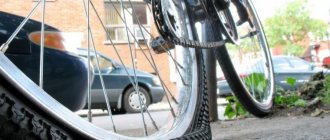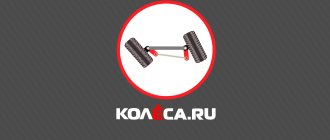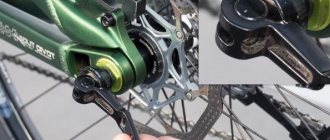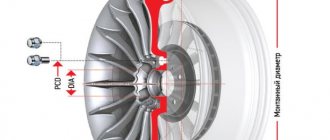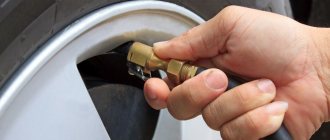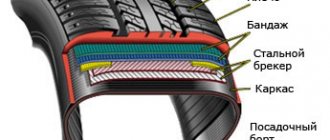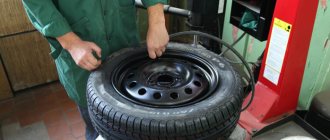Modern hypothesis of the creation of the wheel
The word “wheel” comes from the Proto-Slavic “kolo” and the Proto-Indo-European “kel-so” and means “rotation”. The name “chariot” comes from the same root.
According to the latest data from researchers, the history of the invention of the wheel originates from Europe. The earliest clay wheels were found during excavations of the Trypillian culture on the territory of modern countries (Romania and Ukraine), which are dated 5 thousand BC. e. More “later” finds were made in areas of Germany, Poland and the North Caucasus. Ancient burials of people along with chariots were recently discovered on the border between Armenia and Georgia in the upper reaches of the Kura River (4-3 thousand BC).
One of the prototypes of wheels is considered to be ancient stone millstones for grinding grains into flour. The first wheels were made of clay, stone and only then of wood.
Steering system design
Steering wheel (steering wheel) - designed to control the driver in order to indicate the direction of movement of the car. In modern models it is additionally equipped with multimedia system control buttons. The driver's front airbag is also built into the steering wheel. Structurally, the steering system consists of the following elements:
- Steering column - transmits force from the steering wheel to the steering mechanism. It is a shaft with articulated joints. To ensure safety and protection against theft, the speaker can be equipped with electrical or mechanical folding and locking systems. Additionally, the ignition switch, lighting controls and windshield wiper controls are installed on the steering column.
- Steering mechanism - converts the force created by the driver through turning the steering wheel and transmits it to the wheel drive. Structurally, it is a gearbox with a certain gear ratio. The mechanism itself connects the steering driveshaft to the steering column.
- Steering drive - consists of steering rods, tips and levers that transmit force from the steering mechanism to the steering knuckles of the drive wheels.
- Power steering - increases the force that is transmitted from the steering wheel to the drive.
- Additional elements (steering shock absorber or “damper”, electronic systems).
It is also worth noting that the suspension and steering of a car have a close relationship. The stiffness and height of the first determine the degree of response of the car to the rotation of the steering wheel.
The appearance of wheels in Mesopotamia
According to another hypothesis, the history of the appearance of the wheel originates in Mesopotamia (modern Iraq) and Egypt, where the predecessors of wheels are considered to be rollers that were used in construction (4 thousand BC).
The prototype of wheels was the well-known method of transportation during the construction of the Egyptian pyramids of huge stone blocks using rolling logs (rollers), which was not very convenient, but showed people the possibility of using round objects to carry loads. The Sumerians, who also used logs to move heavy objects, learned to move loads in the same way.
Test
Draw a circle and divide it into six equal parts. Label each part - Physical health, Profession/Finance, Intelligence, Emotional health, Social fulfillment, Spiritual development. Then divide each part into six more parts.
Read each statement and shade the corresponding part of the wheel by the percentage that the statement applies to you.
For example, “I exercise at least 3 times a week for 2 hours.” If this is the case, paint the field 100%, if you do not exercise at all - 0%, if you do short daily exercises - 40-50%. What is important here is not so much accuracy as honesty with yourself. Even an approximate picture will help you figure out the problem areas of the wheel.
The first carts
The history of the creation of the wheel is directly related to the advent of agriculture, because the fertile land in the river valleys of Asia, Egypt and China had to be cultivated. The appearance of such inventions as the plow and sail also dates back to this time.
At first, people began to make two-wheeled carts, when 2 wooden wheels were mounted on an axle. The very first wheels were made from solid logs. Ancient people cut a circle from a log or fastened it from boards, cutting it in a circle.
The carts moved with the help of harnessed animals (donkeys or bulls), but such a cart could only be turned by hand. Later, four-wheeled ones also appeared (around 3500 BC). Of course, such designs were not invented in one year; improvement continued for centuries.
Cave paintings found by archaeologists show carts with a very primitive design: four wheels mounted on axles, and a platform on top to place the load. Such ancient devices were discovered in Mesopotamia, the seat of civilization where the development of metalworking first began.
The spread of wheeled structures occurred in Europe and northern Asia; it is not for nothing that the word “cart” is of Mongolian origin. Images of carts were found in Southern Siberia (mid-2 thousand BC). Nomads even began to make houses on wheels - large carts with a roof. Gradually, such structures reached China.
The next improvement related to the wheel was a design in which the front wheels could turn freely using a swivel front axle. Now people, sitting in the cart, could turn it, controlling the animals.
At the same time, there was a need to build roads so that vehicles could move first between the field and the settlement, and then between settlements they began to transport food and cargo.
Car tire wear
As the vehicle moves, the tire is subject to constant wear and tear. Tire wear affects its performance, including the length of the braking distance. Each additional millimeter of tread wear increases the braking distance by 10-15%!
Important! The permissible tread depth for winter tires is 4 mm, and for summer tires – 1.6 mm.
Types of tire wear and their causes
For clarity, we present the types and causes of tire wear in the form of a table.
| Type of tire wear | Cause |
| Tread wear in the middle of the tire | Incorrect tire pressure |
| Cracks and bulges in the sidewall of the tire | Tire hitting a curb or hole |
| Tread wear at the edges of the tire | Insufficient tire pressure |
| Flat wear spots | Driving features: sudden braking, skidding or acceleration |
| One-sided wear | Incorrect wheel alignment |
You can check tire wear visually using a tire wear indicator, which is a section of the tread that differs in size and shape from its base.
Wear indicator in the form of numbers
The tire wear indicator can be:
- classic - in the form of a separate tread block 1.6 mm high, located in the longitudinal groove of the tire;
- digital - in the form of numbers extruded into the tread, corresponding to a certain tread depth;
- electronic – one of the functions of the tire pressure monitoring system.
( 5 ratings, average: 5.00 out of 5) Loading…
The appearance of chariots
The history of the appearance of the wheel indicates that, along with carts for transporting goods, people began to make vehicles for people. This is how the first chariots appeared, harnessed by donkeys, buffaloes and mules, since horses were not yet used in those days. The ancient people learned to breed the first horses and the breeds they needed only in 2 thousand BC. e. Only wealthy people and military personnel rode chariots.
Most often, chariots were used during military operations. War chariots were common in the countries of Mesopotamia, Egypt and others. Their importance in those days is evidenced by the fact that rich and revered fellow citizens (most often kings) were buried along with their chariots.
The design of these means of transportation developed gradually. At first, these were massive platforms on which stood warriors throwing darts at enemies, or archers. Ancient Egyptian chariots were already lighter and more maneuverable.
The emergence and development of such devices contributed to revolutionary changes in military affairs. The use of such combative and fast transport was often decisive and made it possible to defeat enemies.
Another leap in the wheel revolution was the invention and use of spokes, first wooden, then metal. The use of spokes made it possible to greatly reduce the weight of the wheels themselves and the entire chariot. The next step was the invention of wheel rims.
The further history of the development of the wheel is connected with Europe and the Celts. In the period 1500-1000. BC e. they started using metal for the rim, and then the wheels became completely metal, as did the chariots. But the cargo carts remained wooden.
Ru-Sport.net
The wheel is an elegant and impressive figure practiced in a variety of disciplines, from gymnastics to martial arts. From the outside, the trick looks simple, and indeed, it is the easiest in the program of gymnasts, athletes, and dancers. But mastering it without prior physical training is difficult. The person performing the wheel must have developed balance, coordination, and prepared the muscles of the arms, legs, abdomen, and back. Good stretching and flexibility of the vertebrae and joints are also important.
With proper preparation for physical effort, the wheel can be mastered in one lesson.
Psychological preparation.
The first attempts to make a wheel are associated with fear and inconvenience. This is a natural fear of a creature that usually does not tend to hang upside down without feeling support. The fear of falling arises even before the first try. However, this remark does not apply to children, who are always ready to fearlessly tumble. Such acrobatics are easier for children than for adults.
In order to overcome the initial fear, a simple exercise is recommended: a headstand or handstand with support on the wall, followed by jumping to your feet. This, firstly, will strengthen the hands and shoulders, and secondly, it will convince you of the ability to control the fall.
Place of training.
Ideally, any athletic figure should learn in the gym. The mats will protect you from the consequences of accidental falls, and the instructor will point out mistakes. If this option is not available, a beach with soft sand, a grass area, a pile of leaves, or a snowdrift will do. True, anything can lie in the grass or fallen leaves - from broken glass to rusty iron. The most unsuitable surface for practicing is asphalt.
Methods for mastering the element.
There are two ways to learn how to make a cartwheel:
- Training against the wall.
- Jump training.
The first method is more complicated than the second, but allows you to immediately start “doing it beautifully.” The wall serves as a level that corrects deviations.
When performing the element correctly, the legs should fly exactly above the head. The already mentioned handstand will help in developing this accuracy. First you need to understand in which direction it is more convenient to turn over. You just need to replay the trick mentally: in which direction the movement occurs in consciousness, it will be better to perform the element in reality.
1st stage of training against the wall (flip from hands to feet):
- Achieve a handstand for at least half a minute.
- During the stance, spread your legs as far as possible.
- Lean in any direction.
- Raise your hand on the opposite side.
- Land on your foot.
- Push off with your hand resting on the floor.
- Make houses with a foot that is in the air.
- Stand up.
2nd stage at the wall (flip onto hands from normal position):
- Standing against the wall, lean to the side.
- Throw your leg up.
- Lean on your palm.
- Roll over.
- Submit your other hand.
- Stay in this position.
Stage 3: the described exercises are combined, but holding hands is minimized. Next, you need to speed up the throwing of your body and legs, gradually ceasing to lean against the wall. The last step is to repeat what you have learned in an open space.
The jumping method is technically easier, but requires more control over the correct movements.
1st exercise (standing jump):
- Standing on the ground, spread your legs as wide as possible.
- Bend over, placing your hands as close to your feet as possible.
- Shift your body weight to one leg and jump onto the other, trying to get your legs and body to fly as high as possible.
2nd exercise (jump-off):
- Lean to the side.
- Place both hands on the ground.
- Jump on one leg.
- Push with your hands.
- Swing your other leg and stand up.
What is important here is the smoothness of movements, the absence of a pause when bending, and the effective use of inertia. If you managed to get up from the jump-off, you can proceed to the cartwheel. You will need to do the same, but placing not two hands on the ground, but one at a time. When the body begins to do this automatically, the movement will turn into the desired acrobatic element.
Errors when using the jumping method.
- The hands get used to being behind the line of the legs and head, while the legs and arms should be placed on the same line. It is necessary to constantly stretch your arms as far as possible to the side, without moving them away from the line of your legs. The legs should be thrown as high as possible.
- Bend your arms in a head down position. He threatens to fall or land on his head. There is only one way out - constant strengthening of muscles. They should be able to easily withstand the weight of the body when it falls entirely on them.
Exercises to strengthen your arms.
- Vertical handstand without full support on the wall (only to support balance).
- Plank. A static exercise consisting of maintaining the body in one position.
- Lying push-ups (15-20).
The beauty of a wheel requires flexibility, so it wouldn’t hurt to develop it by doing the following:
- Bends from a standing position (bends to the side are especially useful).
- Torso twisting. To do this, you need to stand straight, tilt your body forward without bending and rotate it around the axis of the spine.
Strong legs are important when spinning a wheel, so you will have to train them:
- Squats. Simple squats will pump up your quadriceps, deep squats will strengthen your calves and develop joints and tendons. In general, strong muscles will reduce the risk of strains, bruises, missteps, and falls.
- Front, rear, side swings with and without support. They will increase the explosive power of the legs and improve stretching. This will allow you to correctly pass through the air phase of the element and land accurately.
To make squats more difficult, they can be performed on one leg with the other leg forward. This will ensure that you get into the habit of keeping your body weight on one of your legs when throwing. You can come up with weights, for example, dumbbells in outstretched arms. This way, when doing squats, you can simultaneously tighten your arms and back.
For the wheel, swinging your legs to the sides is best. Excellent transverse stretching will give the execution of the figure the necessary sweep, clarity, and confidence. Having studied the wheel, anyone will acquire not only the ability to do an acrobatic act, but also improve their physical fitness, develop the vestibular apparatus, and develop coordination of movements.
Hypothesis about the invention of the potter's wheel
According to the third hypothesis, the history of the wheel is connected with the invention of the potter's wheel. It still remains unclear which of them was invented first - a pottery stone wheel, shaped like a wheel laid horizontally, or a wheel in a cart for transportation.
The invention of the potter's wheel also dates back to the Bronze Age. At the same time, the wheel began to be used for making clay dishes in Ancient Egypt; after several hundred years, the Egyptians even began to make dishes on rapidly rotating circles, which influenced the variety of shapes of ancient dishes and their quality.
When choosing a wheel...
And to conclude the topic, the structure of a car wheel, a few words about the marking of tires and wheels. You've probably noticed that there are many different symbols on the sidewalls of tires - all of them are needed in order to choose the right tires for your car.
The main parameters are the width and height of the profile, type of tire and bore diameter. For a disk, important values are its diameter, rim width, as well as the distance between the transverse axis and the plane of attachment to the hub - the so-called offset.
Explanation of load and speed indices:
As you can see, friends, a lot of useful things can be said about a car wheel, although at first glance it does not look like such a complex structure.
Was there a wheel in America?
The question of the existence of the wheel among the American Indians still remains unclear. The Spanish conquistadors, having sailed to America, did not find any wheeled transport, but excavations indicate that the children of the Incas, Aztecs and Mayans had toys with wheels. Apparently, the military invasion of the Spaniards slowed down this process, and the history of the wheel in America did not find its logical continuation.
Similar finds - miniature images of toy wheeled carts were discovered by archaeologists in European countries.
Marking of wheel sizes[ | ]
All wheels have standard markings of parameters, regardless of whether the wheel is light alloy (cast) or steel (stamped). For example, 6.5J×16H2 PCD 5×114.3, Offset48 or ET48 DIA67.1
.
- 6.5
— Mounting width of the wheel rim in inches. - J
- Wheel rim profile (example: JJ, C, CH, HJ, etc.). - H2
- number of “humps” (HUMP) The number of ring protrusions on the wheel rim along the edges (designed to prevent the tire from falling off the seats when lateral forces increase). - 16
— Mounting diameter of the wheel rim in inches. - LZxPCD 5×114.3
- Number of fastening points (in this case 5×). And the diameter of the circle (Pitch Circle Diameter), on which the centers of the mounting holes are located (in this case, 114.3 mm). For drives with four mounting holes, PCD is measured as the distance between the centers of opposite holes. For disks with five mounting holes, the distance between the centers of the holes farthest from each other is measured and multiplied by a factor of 1.051. - ET48 (or Offset 48)
- (ET-EinpressTiefe) Offset (offset) of the wheel mating plane (the plane with which the wheel is pressed to the hub) relative to the axis of symmetry of the rim. The offset can be both positive and negative (example: ET40 - passenger car, ET-4 "Jeep") is measured in mm. In this case it is 48 mm. - DIA67.1
- (DIA) The diameter of the central hole, which is responsible for centering the entire wheel assembly on the vehicle hub. Measured from the side of the mating plane. In our case it is 67.1 mm.
Many wheel manufacturers make DIAs of larger diameter and use adapters for centering on the hub.
Additional marking[ | ]
- 0407
— Date of manufacture. Typically a year and a week. In this case, the information means that the disc was released in the 4th week of 2007. - SAE
,
ISO
,
TUV
- mark of the regulatory body. The marking indicates that the wheels comply with international rules or standards. - MAX LOAD 2000LB
- designation of the maximum load on the wheel (indicated in kilograms or pounds). In this case it is equal to 2000 pounds (908 kg) - MAX PSI 50 COLD
- designation of the maximum pressure in the tire. In this case, the pressure should not exceed 50 psi (3.5 kgf/sq.cm), COLD (cold) indicates that the pressure should be measured when the tire is cold.
Using the wheel in other devices
Gradually, the wheel began to be used in other devices. Over time, it found its use for water devices, according to the records of the scientist Vitruvius already in the 1st century. BC e. Water wheels also spread to ancient Rome. Two types of such wheels were used: gravy (for slow-flowing rivers) and bulk (on fast mountain rivers).
During construction, people also began to use a lifting block, the basis of which is also a wheel. Later, the wheel found another application - a spinning wheel was created for spinning wool. According to historical data, it was invented around 1 thousand BC. e. in India and surrounding areas of Asia.
Section 3. Intelligence
13. I never tire of setting specific goals for the development of my intellect, such as learning a new language or a completely unfamiliar subject.
14. My interests and hobbies stimulate rather than corrupt the intellect.
15. Overall, I am satisfied with my education/vocation.
16. Optimistic thoughts prevail.
17. I would say that I continue to learn throughout my life.
18. I devote time and energy to professional and personal growth.
Improving the wheel design
For several thousand years, the history of the wheel made almost no progress in its development. And only in the middle of the 18th century, a new improvement finally appeared - tires were invented. The first wheel tires were made of thick fabric (canvas) and only then they began to be made of rubber.
One of the impetuses for further improvement was the invention in 1817 by the German professor K. von Dres of the first bicycle, more similar to a wooden two-wheeled scooter (it was called a “trolley”).
The appearance and improvement of the wheel is the most epic invention that pushed humanity to the beginning of the transport revolution, which in the 19th century included railway transport (the structure of which is also based on the use of wheels) and river transport - with the discovery of the steam engine, the first wheeled river steamers were launched.
The next step in history was the creation of cars, and already here the wheel structure has undergone a lot of improvements, which continue to this day.
Types of tires
Tires can be classified according to several parameters.
Seasonal factor
Tread pattern of summer and winter tires
According to the seasonal factor, summer, winter and all-season tires are distinguished. The seasonality of a tire is determined by its tread pattern. Summer tires do not have a micropattern, but there are pronounced grooves for water drainage. This ensures maximum wheel grip on the asphalt.
Winter tires can be distinguished from summer tires by narrow tread grooves, which allow the rubber to maintain its elasticity and hold the car well even on icy roads.
There are also so-called “all-season tires”, the pros and cons of which can be said as follows: they perform equally well in both heat and cold, but have very average performance characteristics.
Method of sealing the internal volume
Based on this indicator, a distinction is made between “tube” and “tubeless” tires. Tubeless tires are tires that only have a tire. In them, tightness is achieved due to the design of the latter.
Off-road tires
This class of tires is characterized by increased cross-country ability. The rubber is characterized by a high profile and deep tread grooves. Suitable for driving on clay and muddy areas, steep slopes and other off-road conditions. But with these tires you won’t be able to develop sufficient speed on a flat road. Under normal conditions, this tire does not hold the road well, resulting in reduced traffic safety, and the tread wears out quickly.
Tire tread pattern
Tire tread pattern
Based on the tread pattern, tires have asymmetrical, symmetrical and directional patterns.
The symmetrical pattern is the most common. The parameters of a tire with such a tread are the most balanced, and the tire itself is more suitable for use on dry roads.
Tires with a directional pattern have the highest performance properties, which makes the tire resistant to aquaplaning.
Tires with an asymmetric pattern perform a dual function in one tire: handling on dry roads and reliable grip on wet road surfaces.
Low profile tires
This class of tires is designed specifically for high-speed driving. They provide fast acceleration and reduce braking distances. But, on the other hand, these tires are not very smooth and are noisy when driving.
Slicks
Slicks are another class of tire that can be distinguished separately. How are slicks different from other tires? Absolutely smooth! The tread has no grooves or grooves. Slick tires perform well only on dry roads. Mainly used in motorsports.
We recommend: The design of a manual transmission and how it works
Which hypothesis is correct
The official and now recognized version of the origin of the wheel considers its homeland to be Mesopotamia or Mesopotamia, which is argued by scientists by the appearance by that time of tools that could not be dispensed with in the manufacture of wheels.
The same hypothesis is presented in schools and other educational institutions; many films and cartoons have been made that tell the story of the wheel for children, its development, improvement and the emergence of new types of transport.
It would be appropriate to mention the philosophical meaning of the wheel “Movement... life... infinity”, which confirms the essence of its discovery.
Production in different countries[ | ]
High-quality wheels are not produced in every country. Moreover, the structure of production of these products is noticeably different. For example, if in Germany or Italy these are manufacturers of auto parts, then in Russia these are metallurgical plants engaged in primary smelting, as well as remelting of metals. However, Russia is not entirely alone in this regard, because for example, the largest manufacturer of alloy wheels in the United States is Alcoa, which is also a large producer of primary aluminum. Wheels from Zinik, which makes wheels for premium cars, are also valuable. In Russia, the production of disks is carried out by the Sayan and Krasnoyarsk and other aluminum plants, as well as the world's largest titanium plant VSMPO. For example, in Germany, manufacturers of such products are the engine company AMG and auto parts manufacturers such as BBS and Lorinser. In Italy, similar products are also produced by companies such as MOMO[1], which produce tuning spare parts.

